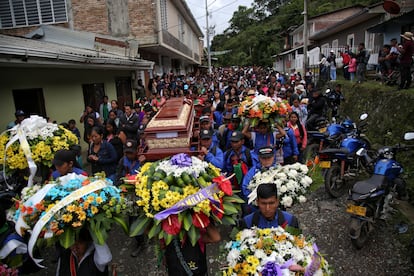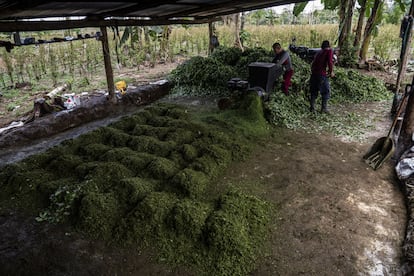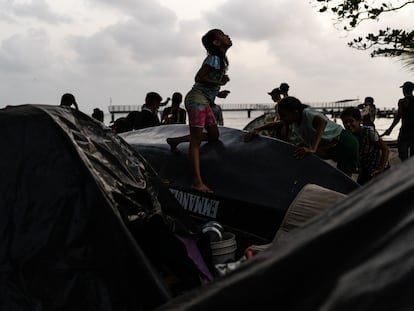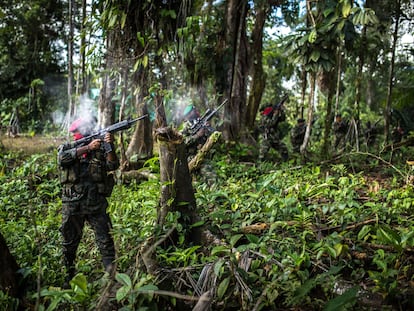Colombia, the deadliest country in the Americas for human rights defenders
A new report from the IACHR reveals that the departments where defenders are killed the most are the areas with the highest production of coca

Colombia is the deadliest country in the Americas for human rights defenders. The Inter-American Commission on Human Rights (IACHR) has been warning of the problem for years, and on Tuesday, it published a report that revealed the situation remained the same in 2023. According to the IACHR report, 126 human rights defenders were killed in Latin America in 2023. Of this figure, 70 were murdered in Colombia; more than 55% of cases. Brazil came in second place with 21 killings. Behind the data, there is a clear reason why Colombia is so deadly for human rights defenders: coca.
The four most violent departments for human rights defenders in Colombia (El Cauca, Putumayo, Nariño and Valle del Cauca) are located in the southwest, where the mix of coca cultivation, drug trafficking and armed groups has led to years of bloody conflicts that mark the lives of the civilian population. The other department in the top five, Arauca, is located on the border with Venezuela, and for years, has been known as a point that exports tons of cocaine to the neighboring country. Here is an overview of the three deadliest departments for human rights defenders:
Cauca
Cauca recorded the highest number of murders of human rights defenders in 2023: 16. It is one of the departments in Colombia that has the highest production of coca and marijuana. Nearly every day, residents are caught in the crossfire of the clashes between the two main armed groups in the country, the National Liberation Army (ELN) and Estado Mayor Central (EMC), more specifically the dissident Jaime Martínez and Dagoberto Ramos columns. According to the report, in 2023, the violence in Latin America was largely targeted against environmental defenders and the Indigenous and Afro-descendant environmental leaders. The Indigenous communities of Cauca and Putumayo were particularly affected.

Researcher Juan Manuel Torres, the coordinator of the Pacific office of the Peace and Reconciliation Foundation, told EL PAÍS in December that the violence in Cauca is due to disputes between illegal groups which affect the Indigenous population. “The majority of the members of the Dagoberto Ramos column of the EMC are made up of Nasa Indigenous people, who have distanced themselves from the Indigenous movement. There are areas that have been raising children for war for a long time. It is difficult to determine the reasons for this cruelty other than the fight for territorial control. Others seek to recruit, ignoring the Indigenous authorities, while organizing the marijuana business in the area,” he explained.
In December alone, five human rights defenders were murdered in Cauca, according to the IACHR. They were Indigenous leader Eliécer Puyo Chocué, murdered in Caldono; social leader John Freiman Ramos Ocaña, in Santander; peasant leader Carlos Arturo Quijano Velasco, in Silvia; Indigenous leader Marino Paví Julicue, in Toribío; and peasant leader Robert Fernández, in Cajibío.
Putumayo
Just south of Cauca, close to the border with Ecuador and the Amazon rainforest, is the second most violent department for human rights defenders in Colombia: Putumayo. There, despite the bilateral ceasefire signed between EMC and the Colombia government in December 2022, the Carolina Ramírez Front has continued with its forced recruitments, “social cleansing” of criminals and its clashes, for which it has become known ― and feared ― in the area. In Putumayo, which is one of the most impoverished regions in Colombia and neglected by the state, nine human rights defenders were murdered last year.
Representative Andres Cancimance, of the pro-government Historic Pact, explained to this newspaper in May that the communities — many of them indigenous — are confined by the clashes between the Carolina Ramirez Front and the Border Commandos, another group of FARC dissidents operating in the Colombia-Ecuador border area. Violence is so entrenched in Putumayo that these armed groups seek to recruit even 10-year-old children. Of the nine human rights defenders killed in Putumayo in 2023, five had their lives taken in Puerto Asis, the department’s largest and most commercial city, with a population of some 64,000.

Nariño
Nariño is the third-deadliest department for human rights defenders in Colombia, with eight killed in 2023. With the Pacific Ocean to the west, Ecuador to the south, Putumayo to the east and Cauca to the north, Nariño has the highest production of coca crops: 59,746 hectares, according to the 2022 report of the UNODC Global Illicit Crop Monitoring Program (ICMP)
The 60,000 hectares of coca crops have attracted numerous armed groups, and sparked fights for territorial control. These armed groups include several fronts of the EMC, the Second Marquetalia and the ELN itself. And they have shown no mercy to the civilian population. According to data from the International Committee of the Red Cross (ICRC), in the first half of 2023, individual displacements in Nariño increased by 33%, with 4,788 victims, and mass displacements by 17%, with 16,137 affected.
What’s more, injuries from explosive devices such as antipersonnel mines claimed the lives of 55 people in those six months. The ICRC also documented 44 cases of disappearances between January and September. The violence escalated so much that in August the then-governor of Nariño, Jhon Rojas, issued a statement on the crisis in the department. “We consider that the humanitarian crisis and the escalation of the conflict in Nariño is very serious,” the document read.
Colombia has been a dangerous country for human rights defenders for decades. Since the peace agreement with the FARC was signed in 2016, the situation has not changed. According to Indepaz, between November 24, 2016, and November 23, 2023, 1,270 human rights defenders were murdered in Colombia, including social leaders, such as representatives of peasant and Indigenous groups. In 2022, the IACHR reported that 126 human rights defenders had been killed in Colombia. Last year, the figure dropped to 70. But Colombia is still by far the deadliest country in Latin America for human rights defenders.
Sign up for our weekly newsletter to get more English-language news coverage from EL PAÍS USA Edition
Tu suscripción se está usando en otro dispositivo
¿Quieres añadir otro usuario a tu suscripción?
Si continúas leyendo en este dispositivo, no se podrá leer en el otro.
FlechaTu suscripción se está usando en otro dispositivo y solo puedes acceder a EL PAÍS desde un dispositivo a la vez.
Si quieres compartir tu cuenta, cambia tu suscripción a la modalidad Premium, así podrás añadir otro usuario. Cada uno accederá con su propia cuenta de email, lo que os permitirá personalizar vuestra experiencia en EL PAÍS.
¿Tienes una suscripción de empresa? Accede aquí para contratar más cuentas.
En el caso de no saber quién está usando tu cuenta, te recomendamos cambiar tu contraseña aquí.
Si decides continuar compartiendo tu cuenta, este mensaje se mostrará en tu dispositivo y en el de la otra persona que está usando tu cuenta de forma indefinida, afectando a tu experiencia de lectura. Puedes consultar aquí los términos y condiciones de la suscripción digital.
More information
Archived In
Últimas noticias
Most viewed
- Sinaloa Cartel war is taking its toll on Los Chapitos
- Oona Chaplin: ‘I told James Cameron that I was living in a treehouse and starting a permaculture project with a friend’
- Reinhard Genzel, Nobel laureate in physics: ‘One-minute videos will never give you the truth’
- Why the price of coffee has skyrocketed: from Brazilian plantations to specialty coffee houses
- Silver prices are going crazy: This is what’s fueling the rally











































